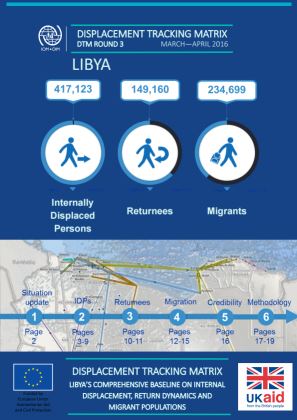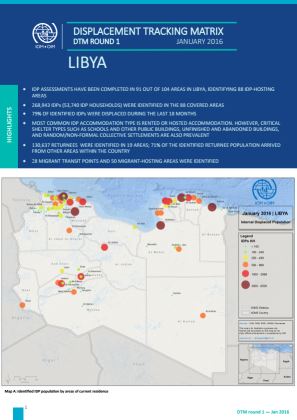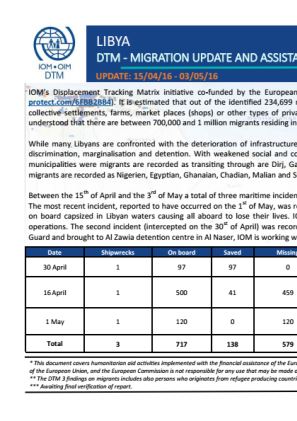-
Countries
-
Data and Analysis
-
Special Focus
-
Crisis Responses
Libya
Sobre Libya
Libya is a geographically vast country with several regions that are difficult to access. In order to understand the full scope of humanitarian assistance that is needed throughout the country, IOM established the Displacement Tracking Matrix (DTM) programme in 2016 in order to provide a common operating picture concerning the movement of populations in Libya, allowing humanitarian actors to provide timely assistance to those in need. Following the escalation of conflict and insecurity in 2014, the security situation has remained volatile since with fluctuations in the intensity of localized clashes. Congruently, conflict has caused new displacements, often in areas ill-equipped to accommodate large population movements while also negatively impacting the large migrant population residing and transiting through Libya. More recently, the capital Tripoli was heavily affected by displacement waves in September 2018 and April 2019.
DTM’s mobility tracking and flow monitoring activities identified many migrants in-country to be in need of various forms of assistance. Libya’s geographic location, resources and work opportunities has made it both a country of destination and transit for migrants for many years. Despite the deterioration of the security situation since 2011 migrants continue coming to and transiting through Libya, the majority from Sub-Saharan and North African countries.
In this complex operating environment, DTM Libya has been providing a common operating picture concerning the movement of populations in Libya since 2016, allowing humanitarian actors to provide timely assistance to those in need. Through its mobility tracking, flow monitoring and needs assessment activities, DTM Libya has established itself as data hub for quantitative data on migratory flows to and within Libya, migrant presence in Libya disaggregated by nationality and area, as well as humanitarian needs of migrants, internally displaced population and returnees. All activities are implemented through periodical bi-monthly data collection cycles, allowing trend analysis over time to provide evidence-base for both policy-level discussions and to guide humanitarian action.
In order to facilitate humanitarian interventions, DTM works closely with IOM’s other programmes through referring identified populations in need of assistance at flow monitoring points to IOM’s Direct Assistance, Health, Voluntary Humanitarian Return (VHR), Protection and Migrant Rapid Response Mechanism (MRRM) programmes. Furthermore, DTM Libya supports other humanitarian partners through providing emergency tracking updates in case of sudden population movements as well as facilitating humanitarian assessments for the Rapid Response Mechanism (RRM) jointly implemented by IOM, UNICEF, WFP and UNFPA.
For more information on IOM's activities in Libya, please visit the IOM Libya country office website.
Contacto
DTM Libya
DTMLibya@iom.int
Current Donors
- EUTF
Para obtener resultados de búsqueda más avanzados, vaya a la Página de búsqueda avanzada de informes
Libya — IDP & Returnee Report 3 (March 2016)
DTM assessed all accessible areas of Libya, covering 100 areas out of 104 (Harawa, Sirte, Al Jaghbub and Misratah were all reported as inaccessible). IDPs were identified across 95 areas, returnees were identified in 13 areas and migrants across 29 areas.
Mar 31 2016
Libya — IDP & Returnee Report 3 (March 2016)
Libya — IDP and Returnee Report 2 (February 2016)
This assessment covered 99 areas and 470 locations. DTM identified 331,622 IDPs in 95/99 areas (within 440 locations). DTM interviewed over 800 key informants. In addition, 150,637 returnees have been identified in 19 areas. Displacement from Sirte has continued.
Libya — IDP and Returnee Report 1 (January 2016)
IDP assessments were completed in 91 out of 104 areas in Libya, identifying 88 IDP-hosting areas. 268,943 IDPs (53,740 IDP households) were identified in the 88 covered areas. 79% of identified IDPs were displaced during the last 18 months.
Jan 01 2016
Libya — IDP and Returnee Report 1 (January 2016)
Libya — Migration and Assistance Overview (April 2016)
During the reporting period covering the 1st to the 15th of April 2016 IOM recorded four shipwrecks of the coast of Libya. In total, DTM recorded 511 migrants from 11 April - 12 April 2012. More than 17,500 stranded migrants and 8,500 IDP families have received NFIs and hygiene kits since 2014.
Libya 2016 Migration Profiles and Trends (July — December 2016)
11,250 crossing migrants were identified through 489 FMP baseline assessments from July to December 2016. During the same time, DTM analyzed 8,135 migrant surveys. The main nationalities are Niger (24%), Egypt (21%), Sudan (13%), Nigeria (9%), and Chad (6%).
Pagination
- First page
- Previous page
- …
- 18
- 19
- 20
- 21
- 22
- 23
- 24
- 25
- 26
Para obtener resultados de búsqueda más avanzados, vaya a la Página de búsqueda avanzada de conjuntos de datos
Pagination
- First page
- Previous page
- 1
- 2
- 3
- 4
- 5






